Road to a startup business in Thailand
Want to have a startup business in Thailand? We did too. After living in Thailand and Southeast Asia for years, my colleague and I decided to start a business in Bangkok.
This is the story about our journey as we navigate the fascinating system of Thai business and bureaucracy. As technical professionals, we’re both fascinated by challenges and, as well, a bit stubborn when it comes to solving them.
If you want to test your patience and resolve, there is no place like Asia.

Starting Out
We have both been in the region for years and have many friends with businesses in various states of legality. Tales of archaic and contradictory requirements were common: hire four Thais and get an office before you can even work; be a minority stake holder in your business; strange rules about size and placement of office signs. The list went on and on.
No one made it sound pleasant or even worthwhile. Until we heard about the BOI.
Learning about the BOI promotion
The Thailand Board of Investment is a government office dedicated to promoting investment in Thailand. More interestingly, the BOI offers tax and non-tax incentives to promote investment in various “activities”. One of those designated activities looked promising, section 5.7 (Software). More specifically, the details of 5.7.2 (Enterprise Software and Digital Content), would probably cover a SaaS business, including our new venture, Outsmart.
The incentives are rather generous and reduce or eliminate many of the requirements our friends warned us about. The ratio of Thai to foreign employees is relaxed, and we even wouldn’t have to hire Thais for up to two years. We could work from a co-working space, we both could get work permits, and we wouldn’t have to pay tax.
Sounded like sweet music for our ears, so we decided to give it a go.
Getting involved with business lawyers
Encouraged by the positive information, we frantically started to search the web on how to get BOI incentives. Details were sparse with most info coming from local legal offices who, when contacted, were quick and happy to help for a price of around 200K Thai baht or more.
We read that the BOI process was free, so this sounded a bit steep. Armed with equal parts frugality, masochism, and naiveté, we decided to handle this process ourselves without lawyers.
In hindsight, I still don’t know if this was the correct path. It took close to three months of taxi rides and extreme frustration. We did it though. And we learned a lot about how business works in Thailand–the real nitty gritty not discussed casually over beers.
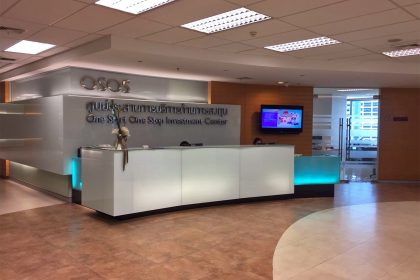
Getting acquainted with OSOS
We knew from before that there was a BOI related office in central Bangkok, so the One Start One Stop Investment Center in Chamchuri Square was our first stop. This is a surprisingly modern resource for Thailand dedicated to helping with applications and answering questions about doing business in Thailand.
Eager to get going, we quickly searched online and found the BOI application form. Though filled with strange questions and mysterious boxes, we did our best to complete what we could and headed over to Chamchuri Square.
We told the OSOS guy that we wanted to apply for BOI incentive and showed him our form attempt. He spoke good English and offered his suggestions, clarified some parts, and adding to the confusion in others.
His main concerns were the sections about Thai employees (6.2, 6.4). He suggested the classic (and dreaded) 4 employees the first year with a minimum combined salary of no less than 1.5 million THB, which he said was just what they wanted to see and wasn’t required by the promotion.
Two important line items are registered capital (2.1.1) and shareholders (1.5). Registered capital minimum is 1 million THB; shareholders minimum is three. Estimated revenue (7) was set to modesty increase, along with staff and expenses, over the three years outlined in the form. After a few rounds of revisions, he sent for his boss who helped re-revise a few more items. When they were finally satisfied, we were told the application was ready to be submitted at the BOI office and sent on our way.
We were happy and about to leave for the BOI head office when the OSOS guy suddenly suggested that we could submit our application online. We were told they would be proud to have us the first to try their new online service.
We eagerly started to transfer our application data to the online form hoping we could save some time. To our surprise, there was a sudden error, and we couldn’t continue. The OSOS guy shyly admitted that maybe it wasn’t that great an idea after all and suggested that we were probably better off submitting our application at the main BOI office in Chatuchak district. The perils of the early adopter!
The whole visit took about two hours. They were friendly and patient but ultimately happy to see us leave.
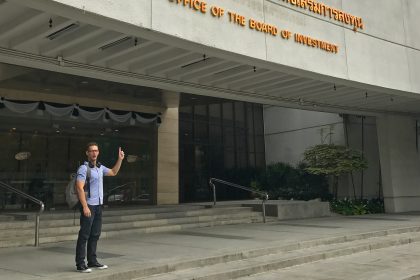
Applying for BOI privilege
The next day, confident with a form scrutinized and perfected, we headed to Central Lat Phrao to visit the main Board of Investment office. We first took the BTS and then MRT, walked across the mall, and over a highway bridge to the BOI main branch. Note: take a taxi instead.
We were told by staff to check in at the Resource Center near the elevators. We did as told and a few minutes later a senior male staff member sat down with us in the library to look over our form. The man scanned through and proceeded to mark it like a teacher grading a failed exam. We had apparently not done a good job at all and requested a fresh form to fix the scribbled mess.
There were all kind of mistakes and changes required. For example, we couldn’t include Microsoft Office as a software expense (section 5.7), because that was of course included in all Windows machines (obviously in Thailand). Then there were a few issues with Thai versus foreign quota under employment (6.2). He suggested us to write down 2, 4 and 6 Thai employees for the coming 3 years. We also had to devise a detailed plan on how to train our future Thai employees (6.3). Lastly, all foreigners’ salaries were corrected to ~50K (6.4).
They were taking lunch, so we headed to Central Lat Phrao to update our application. After a quick lunch, we returned with our revised masterpiece, met up with a nice lady who was our assigned officer, and learned more about the BOI. Our application was finally acceptable.
Our officer mentioned that technology transfer is a main reason for software being on the promotion list and suggested for our interview that we be prepared to describe how we would train Thai staff. She also stressed that only new enterprises started in Thailand are eligible, no existing products from overseas.
Luckily, we fit the bill. We submitted our application and hoped we’d be approved for an interview, which must be scheduled within ten days.
Interview and project evaluation
A few days later we got our approval email from BOI and had a confirmed interview four days later. Very quick. Encouraged, we tried to prepare a presentation about Outsmart for the agent.
We searched online to find details about the BOI interview. We found some information but nothing definitive. Many of the business details were covered in the application, so we decided to create a PowerPoint presentation outlining our business plan, competition, and plans of world domination. We expected a room of frowning Thai officials determined to find something amiss.
The day came around, so off again to the Chatuchak area and the BOI office across the little bridge from Central Lat Phrao, well prepared with our business plan, passport copies and CVs.
We met our officer who passed us off to another young lady agent, who would conduct our interview. It was just the two of us and her at a small table in the corner of the busy office. We unpacked the laptop and opened our presentation, happy and relieved our expectations were incorrect
She asked about our business and seemed genuinely interested, being especially inquisitive about if we’d started already — a specific our assigned officer had informed us about. The mood was light as we explained our work experience and bumbled through how we could pass on our knowledge.
We mentioned that we have looked at a few co-working spaces, and that we wanted to use that as our office. She seemed fascinated and had no problem with a BOI company working from one. She further explained that her job was to present our business to her bosses, who would ask her the same questions she was asking us. They would ultimately approve the incentive.
Everything went very well. We were out within 45 minutes, and were told we’d to hear back within 40 days.
Picking up our BOI approval
13 days after our interview session, several days before expected, we received an email telling us that our project evaluation was accepted and we were now granted a BOI approval. For a third time, we headed back to the BOI office.
Our agent picked up a few applications, handed them over to us, and told us to fill them out. After completion, she directed us up to the 3rd floor to drop them off.
To our surprise, we had been given the incorrect forms and were directed down again to the 1st floor by an angry senior management lady. Our agent looked a bit confused and after a brief discussion with her secretary we got a bunch of new papers, which we started to fill in.
This time our application was correct and could be traded for our shiny BOI approval letter. We felt proud. We had managed to complete the first step relatively unscathed. We were ready to set up our business.
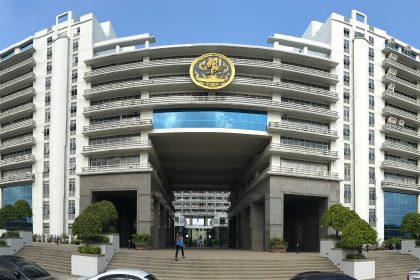
Setting up a Thai business
A few days later we were ready to incorporate our company as a BOI business. We got told that a software company must be incorporated at DBD’s head office (Department of Business Development) out in Nonthaburi, so we called an Uber taxi and were on our way.
We reached the foreboding Ministry of Commerce building in which the DBD office is located and within minutes we quickly found the correct office at 3rd floor. It looked like a huge sterile place, almost like a hospital, it was packed with people, all nicely lined up in rows of chairs and we directly felt kind of lost, as there were absolutely no visual signs on where to start.
It looked like everyone in that room was waiting in some kind of queue, but we couldn’t find the usual small number machine. We asked one of the ladies working there, who looked back at us with a grim face and told us in broken English that the BOI department was on the 8th floor.
We headed up the 8th floor, walked into the second DBD office, and were quickly told that an incorporation was done on the 4th floor, as this was only the office for a company registration under the BOI privilege. We took the elevator down again and walked into a third DBD office.
This office looked like the first one, same layout, same chairs, same type of weird, informal queue. One counter had a sign reading ‘e-commerce’, which seemed appropriate. We walked over, handed over our BOI documents to the lady behind the desk, and told her we wanted to start a software business.
She looked at us like we just arrived from Mars or somewhere from outer space. Our Martian was clearly indecipherable, as she sat blinking, not understanding a word of what we said.
Luckily, a younger lady in the office noticed us and politely asked us to wait 5 minutes by the coffee table. She could come over and help us once she was done with her current task.
The younger lady was friendly and explained how the incorporation process was set up in Thailand. The application form must be completed in Thai. She suggested us to start with a reservation of a company name. She further explained that a reservation of a company name could be done online on the DBD website.
In fact, the whole process can be done on the DBD website. She added that on completion, we would receive an appointment slip, which was used in place of queue numbers in their office.
She asked us if we were interested in a quick demonstration of their online system. We idiotically declined and deciding we can figure it out. We also wondered why the OSOS neglected to mention this time-saving step.
After a half day of running up and down the Ministry of Commerce building, we headed back and were ready to go online.
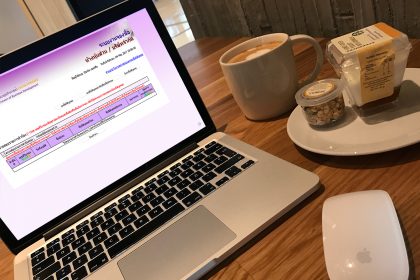
Register a company name
Eager to get going, we opened up our browser, navigated to http://eregist.dbd.go.th/, registered an account, and with a bit of trial and error and help from Google translate, we managed to figure out how to reserve a company name (written in both English and Thai).
A day later, we got notified that our name reservation has been granted and was now registered in the system. As we had understood from our visit to DBD, we could now start the incorporation process. So far, so good.
Submitting incorporation online
During our clicking around while registering a company name, we had managed to figure out how and where to incorporate a company via DBD’s online system. Our registered company could now be used to start with our application.
We invited one of our Thai friends over for dinner and asked her to be ready and assist us with a bit Thai translation and writing. The online application looked easy; we thought it would be a quick thing, but the early evening became late evening and the restaurant was about to close for the day. Stressed and tired, we finally reached the end and there it was, the shiny beautiful submit button.
Relieved and happy, after 4 hours and 16 pages later, we submitted the form.
Re-enter the information
A new morning and eager to know about our application process, we fired up the browser, logged into DBD’s website, and navigated to the application status page. We had a quick look at the table, but noticed that the status was unchanged.
Curious to check our form data, we clicked the view application button. To our surprise and dismay, it was blank — every single page was totally empty. What a nightmare.
Frustrated and angry, we decided to give it a second try. We luckily had a copy of all written content in Thai saved in a separate document, so filling in everything a second time was way quicker.
It suddenly became more challenging, as we noticed the form randomly lost values and failed to save properly. An hour later, with the data looking correct, we finally submitted our application a second time.
Each day we logged into the DBD system to check our application status, and each day it was as the day before: “In process”. We started to get worried and decided to call the DBD office and ask about it.
We picked up the phone and dialled the number to the office. We explained our situation to the guy on the line and supplied him our application process number. He told us to wait, and after a brief minute he was back. He was confused as to why we used the online system. Everyone must complete the paper forms to submit in person at the main DBD office he said.
Weird and wonderful applications in Thai
It was now confirmed: skip the online application. We were told it has never really worked unless you use Windows 7 with Internet Explorer 8 or some other obsolete combination (instructions manual). The DBD did not even use it for anything except company name registrations. This all sounded very logical, especially to two guys working in UX and web development for the past 10 years. At least we knew why the OSOS sent us directly to Nonthaburi.
The man from DBD also told us that all application forms could be downloaded online from their website. He gave us a link to an instruction manual and a page containing all necessary documents, which were form-fillable PDFs.
Application preparation handbook
Application for a limited company registration
Happy to get going, we called a colleague’s girlfriend a second time and we agreed to meet at a coffee shop. Armed with a whole stack of application forms and the information we have collected from our online application attempts two weeks earlier, we started to fill them out one by one.
There were nine documents in all, but most contained similar information to the online forms we had spent hours trying to complete online. The process was quick and we felt like professionals now. An hour and half later, we were done.
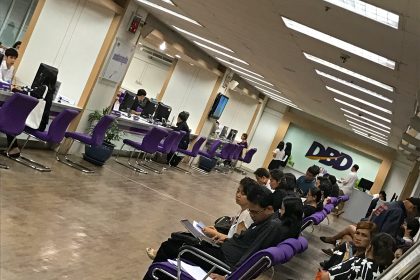
Heading to the DBD
The next day, we printed out our application forms and headed to the DBD’s office a second time. This time we were full of confidence. We knew our stuff and had fresh experience in filling in the Thai application forms.
We arrived early and somehow got a lady to give us a queue number, as the broken website didn’t give us an appointment slip. After around 20 minutes, it was our turn.
We handed over our application papers to the lady at the desk, and told her we wanted to start a company. She briefly looked over all our papers, walked away, and came back with an older lady. The older lady looked like some kind of manager and definitely did not look friendly or happy to see us.
She leaned over to us and said firmly in a strict manner, what kind of document is this?
We looked at each other, quite surprised and asked her back. What… we do not understand, eh, we were told that these are the papers needed. She then responded, do you have a company stamp?
We looked at each other and were now even more surprised. We answered back, no we do not have a company stamp, we do not even have a company; that’s why we are here.
She answered in a troubled manner that we had to create a company stamp to continue. She also told us that we could get a stamp in any of the shops outside the Ministry of Commerce building and to come back when we were ready. It also seemed our papers were incomplete.
Specialized print shops
With a bit of hope, we walked out of the DBD building and out on the street. Across on the other side, we could clearly see that there were a bunch of small shops that was offering services like copying, printing, stamps etc. We walked into a random store.
The guy in the shop, directly asked us if we needed help with incorporation papers, like he already knew that we got rejected. We told him we probably only needed a stamp, but said he were welcome to have a look at our papers. He shook his head and suggested we completely rewrite our application to be sure it got accepted. First we need to create a stamp he said. He asked us if we had a design for a stamp and told us it must contain the company name in Thai.
We did not have a Thai company stamp design in a back pocket. No worries he said; we will create one for you, just give us a logo. Luckily, we brought our laptops. We found a logo and sent him one in a vector format. Another guy in the office whipped up a stamp layout including our logo and Thai company name. With a little tweaking we had an acceptable company stamp.
Meanwhile, the other guy started to print out a bunch of application papers and quickly started to fill them in with information from our other papers. He suddenly asked us, do you have an office certificate?
We told him that we have a space in a co-working space, wasn’t that enough? The agents at the BOI office certainly thought it was fine. No, he said. According to DBD, it’s clearly unacceptable — you need a contract of a rented office space or a registered house that can be used as an office.
We felt stressed and wondered if we would ever get this company set up. We started to call around to a few different co-working spaces, asking them about an office address. They told us that we couldn’t use them as an office to register a company. They also suggested that they could give us an address for a fee, which hardly sounded legit.
Luckily we got the address sorted out, and an hour and half later we had a completely new application form, company stamped and signed. We paid 800 baht for their fine work and headed back to the DBD office. Thank you guys.
Ready for our incorporation
With new hope, we were now back at the DBD office for our fourth attempt to set up a company. A bit relieved we did not have to come back here another day, we found the grumpy lady and handed over our papers.
She looked a bit happier this time and told a younger man next to her to start the application process. He looked over our papers and asked us to sign, initial, and clarify a few things here and there. Then he reached the shareholder list and looked at one of the passport copies.
There was obviously something very wrong with our partner’s passport and the shareholder list. The guy walked away and brought back the lady. She firmly told us that the name in the shareholder list and the passport copy did not match, so they couldn’t continue with the application.
We looked at each other again and it felt like here we go again. We asked her what was wrong. She told us the characters on the application and the shareholder’s passport did not look the same. (Note: our minority third shareholder is Icelandic with a ‘T’ in his name.)
We told her it was an Icelandic T (Þ) and it indeed was a correct translation from Icelandic to English. She refused to accept it, and told us that this passport holder must come to the office and bring paper from his embassy stating his name correctly.
Confused and totally lost, we called our partner. He started to laugh and told us he always had issues with these Icelandic characters and an English translation. He agreed it was weird that his country still issues passport with Icelandic characters. He calmed us down and said that there was an English translation of his name along the bottom strip of the passport.
We explained to the lady that our partner’s name was written in English and showed her how to find it. She examined it closely and nodded her head. The younger man looked as relieved as we did and continued his work.
Finally, he said, you’re done. Just paid the fee in the cashier and you can pick up your company registration papers on the 4th floor.
Concluded a long day and a weird journey, we now had our Thai company.
Getting our BOI certificate
The next day, ready and with a freshly set up Thai company, we headed over to the BOI office a fourth time. Today was the day to pick up our final BOI approval certificate and we were filled with hope tempered with preparation for disappointment.
We taxied out to the BOI, took the elevator up on the 3rd floor, and stepped into the office. We handed over our company registration papers to the young guy that we’ve been in contact with before, and told him that we were ready for a final BOI approval.
He started to sign off our papers and then he suddenly stopped. He asked us to see the bank statement showing incoming capital. We looked at him and replied, what statement. He then explained we need to show proof of an incoming money transfer worth 25% of our company’s registered capital into our company bank account from abroad.
A bit confused, we asked if it was okay if we could show a proof of that kind of capital on a personal bank account. No he said, it must be a bank account registered in your company name. How about transferring money from a personal bank account to a company bank account, we asked. No again. The that money must be transferred from abroad. Dejected and without any BOI certificate, we left the office.
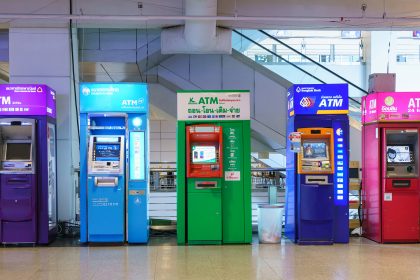
Open a Thai business bank account
A few days later, prepared with a stack of papers and our cool company stamp, we headed down to our local Kasikorn bank, ready to open up our company bank account. After ages in the queue, we walked up to the teller, told him we wanted to open a bank account for our company, and handed over our papers.
He quickly browsed through our papers and instantly and abruptly asked to see our work permits. Confused, our new default for this journey, we told him that we can’t get work permits without first setting up a bank account. The bank account was needed to complete the final step in our incorporation process, and we need that to get a work permit, we told him.
He firmly rejected us and said that the rules in Thailand state all foreigners must show a work permit and three months of salary slips to be allowed to open a bank account. We also needed a VAT number, he rudely added, as he pushed our document back at us.
We couldn’t understand was he was talking about. Was she making up rules? This did not make any sense. How could we ever complete our incorporation process if the necessary tasks required each other? And what about this VAT number?
Frustrated, we left the bank and called our agent at the BOI. We explained our failed attempt to open a bank account and asked him how could we possibly continue. He was surprisingly calm and quickly explained that the papers we already had should be allowed to open a bank account. The VAT number was actually our business ID number. He was actually quite surprised the teller didn’t know any of this and suggested we try a different bank.
We decided to try again the next day and visited Bangkok Bank hoping for better luck. The staff were efficient, helpful, and keen to get us going and had no issues with us being without work permit. They easily found our VAT number on the front of the first page. After an hour of paperwork, stamping, and signing, we now had our corporate bank account.

Finally a BOI certificate
A week later we completed the international transfer of our required capital, printed the confirmation certificate from Bangkok Bank, and headed back to the BOI office for a fifth round. We went up to the 3rd floor, stepped into the office, and handed over our papers a second time.
Our agent looked happy to see us again. He hesitantly asked for our certificate of deposit from the bank. Happy to have it, we handed it over, and he, seeming much relieved, continued with our papers where he left off the last time. After few minutes, he walked away and returned with a sturdy blue folder decorated with gold lettering. He handed it to us. This is your BOI certificate, he said.
Register a company under BOI
With our diploma-like BOI certificate folder, we were ready to complete the final step of associate the BOI privileges to our new company. An Uber ride later, we reached the Ministry of Commerce building in Nonthaburi and visited the BOI department of DBD on 8th floor.
The department was deserted and the staff was quick to help us. They told us to sit down, asked for our shareholder list, company registration papers, BOI certificate, and gave us a paper for us to sketch a map over our office location.
We did as directed and we signed and stamped everything needed. They asked us to pay a fee of 20,000 baht, 5 baht per 1000 baht of our company’s registered capital. We were handed a receipt and told that the process would take 30 days.
After 7 days, we got a phone call and the lady on the other side, said our BOI registration was ready and that we could come and pick it up.
For a fourth time, we took a taxi out to Nonthaburi, but this time we knew it would be a rewarding trip. 45 minutes later, we reached the DBD office, walked up to the 8th floor, and greeted everyone as usual. We handed over our receipt to a lady, who already knew us from our previous visits. A minute later, we had our final approval letter and a fully legit BOI company.
Applying for a work permit
With a legal Thai company, the last step was to get a work permit, so we could actually start working on our startup. It had taken 2 months to get to this point. Off we headed to the OSOS office at Chamchuri Square for a second time.
We took the elevator up on the 18th floor and walked into the office with our 2 kg of corporate papers. A familiar face showed up. It was the agent from first time at this office. He cheerfully asked if he could help us, and we told him that we were ready to apply for work permits.
He then explained we must register our company in their online system before we could continue. Still traumatized from our last encounter with their online system, we asked him to go explain. This system, he told us, was set up for BOI companies to register their foreign staff. Each employee/founder must be approved in the system to get permission to apply for a work permit and visa.
He gave us a form to fill and asked for 200 baht as a registration fee. In return we got an new company paper to add to our already huge stack of other related documents. We would receive an email within days with login credentials and password to their system.
We left and took the MRT back to our office.
Requesting permission to work
Later the same day we received the promised email. It contained login credentials to their e-Expert System, as it was called. We clicked on the link in our email, logged into the system, and quickly and cautiously got to work.
We got told that we should fill out form 1.1 (Application for foreign experts positions), 4.1 (Bringing in foreign expert and family to work in the approved position) and 7.1 (Request for cooperation in visa stamp) for each foreign employee in our company.
The system was well laid out, and we directly understood what to fill in and where. First, we needed to set up job roles by explaining the position and expertise level. For each role, we also had to submit a detailed plan of how we should transfer expertise and technology knowledge to our future Thai staff. Last but not least, there were a few questions about annual sales revenue and operating results (not sure how that is related to a job description). This was basically the same type of stuff on the initial BOI application.
Second, once an expert position was approved, we had to add the foreign employee as an expert in the system. Each applicant then has to submit a certificate of education, previous employment experience, and a brief description on why he is qualified for the role. Each document is submitted via PDF in the form.
There were numerous fields and files and the system was constantly timing out after about 10 minutes and we had to redo the whole process repeatedly. We unwittingly became experts on the e-Expert System without even needing further documents or approval.
After several emails, back and forth and a few resubmitted e-Expert applications, we finally got our permission to work. It was a single page document that allowed us to apply for a visa and work permit at OSOS.
Ministry of Labour
We headed over to the OSOS office at Chamchuri Square, once again, for the third and hopefully last time. This time we were ready to finally get our visa and work permit. We waited in the long visa department and handed over our papers. The grumpy lady in the reception, grunted and snarled at us to write down our phone number on our applications.
A few minutes later, they called our names (not phone number) and were greeted by a younger lady. She asked us about our current visa status. We told her that we had recently applied for the 30-day extension on our tourist visa. She told us that it made the process a bit more complicated — a non-immigrant or non-extended tourist visa is required before continuing. We would otherwise be able to swap our current visa to a new BOI visa without leaving the country, but that was currently not the case.
The lady handed over two documents, telling us that these would be enough for us to be granted a Non-Immigrant Visa B at any Thai embassy abroad. I thought that was a bit strange, because on the Ministry of Labour’s website, it says in clear text that each applicant must bring a Letter of approval from the Ministry of Labour.
She then responded that she wasn’t aware of that requirement and told us that she had to check with her senior staff. 10 minutes later, she came back and said that we probably had to request a Form WP3 at the Office of Foreign Workers Administration.
Thankful but confused, we took a taxi out to Din Daeng and the foreboding Ministry of Labour building.
Finding the office was easy. There were probably several hundred people waiting for their turn to get served in this classic, Thai government office. The reception lady, the true gatekeeper of the place, looking exasperated and annoyed, basically screamed at us to tell her what we wanted.
It took us with a bit surprise, but we calmly explained that we would like to get a letter of approval for a Non-Immigrant Visa Category “B” (Business Visa) for a BOI company at a Thai consulate abroad. We handed her our registration papers.
She dismissed our papers and asked to see a statement of social security payments for our Thai employees for the last three months. We thought, perplexed, if we do not even have work permits, so how can we have Thai staff.
We talked to an older man next to us, who looked curious and understood English, trying to explain what we were looking for. He then tried to explain or situation to one of the staff members who joined the discussion.
The unreceptive receptionist then responded loudly that we must have work permits to apply for anything and that we could not get a letter of approval without one. Sensing the familiar chicken-and-egg scenario, we asked to see her boss.
The older man walked us over to the boss, and we tried to explain our situation a third time. We showed her the requirements mentioned on their website and handed over all papers we had. She looked over them and decided we must visit our local Ministry of Labour office in the jurisdiction of our company office.
Frustrated, we realized that we would get nothing of value out of the Ministry of Labour. We decided to take a chance, hope for a bit luck, and apply for a visa with the help of the papers we already had.

Travel to Singapore
A few days later we flew to Singapore and we woke up early to visit the Thai embassy over on Orchard Road. With all required papers, minus the mythical WP3, and feeling somewhat confident, we took a number and waited.
Twenty minutes later it was our turn, we stepped up to the counter, handed over our papers and form, and said that we wanted to apply for a Non-Immigrant Visa B. The younger lady on the other side looked over our papers and quickly responded, where is your invitation letter?
We both thought, oh no, here we go again, but calmed down and asked what kind of letter she meant. She explained that the owners of the company must write an invitation letter, stating that the employee will work for their company. We then responded that the owners are standing here in front of you, so it makes no sense to invite ourselves.
She was firm and told us to come back when we had an invitation letter. We started to feel the stress and suddenly realized that we couldn’t come back the next day, as that would require us to reschedule our non-refundable flights and stay a day longer in Singapore.
We quickly left and walked into the hotel next door and asked if it was possible to use the printer. The man in the lobby nodded his head and said it would be 10 Singapore dollars. We realized that they probably had a lucrative side-business from frantic travellers needing documents quickly.
Luckily, we brought our laptops and miraculously had an invitation letter template from our research stashed on Dropbox. A few minutes later, we had printed letters explaining to ourselves how we would be ideal employees for our own company. We still had 20 minutes left before the consulate closed.
We ran back to the embassy and barely made it in time to hand over our application papers for a second time. The lady had a quick look at our invitation letters, and told us that we could pick up our visas in two days.
Getting a BOI visa
Back in Bangkok and with fresh visas from Singapore, it was (finally) time to apply for a promoted visa and work permit. We headed over to OSOS a fourth time.
We walked over to the grumpy lady, once again and handed over our application papers. She greeted with her charming manner, just as the last time and after a few minutes, she replaced our current application paper with a new paper and told us to proceed to the work permit section.
It took us a while to find the correct queue, but once we did, we handed over our papers and photographs required for the work permit. The man abruptly responded that the photo could not be used and pointed to a description on the wall, showing various examples and dimensions of acceptable photographs.
Our photos were the proper size, we wondered, so what is possible wrong with it. He told us that this was an official business document and the person in the photo could not wear a t-shirt, as my colleague was in his photo. Always dress appropriately, folks. He had to take a new photo.
We explained that we did not have a shirt or a suit. He then quickly responded, it’s fine, the photographers on 4th floor can photoshop a suit and tie into the photo. We wondered why, if it was that important, they accept a fake suit on the photo. We were just glad to have a solution.
We accepted the fact, went off to take new photos, and came back. Our application was now accepted, and we proceeded with first our work permits and then the matching visas. It was a slow process and after 6 or 7 seven hours we finally were done.
At the end
For a more detailed breakdown of time and costs, see our How to setup a startup in Bangkok.




